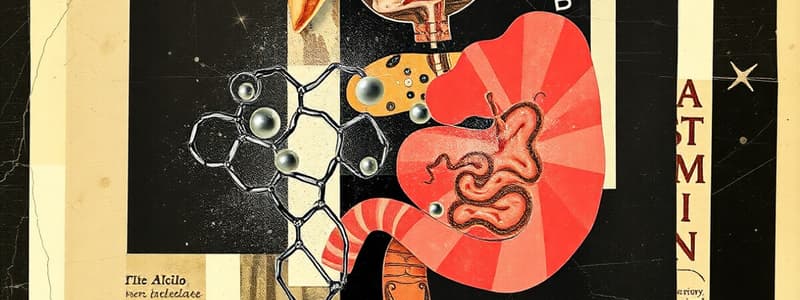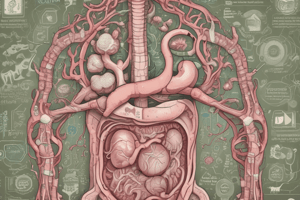Podcast
Questions and Answers
เนื้อหาด้านใดเกี่ยวข้องกับการทำงานของกระเพาะอาหาร?
เนื้อหาด้านใดเกี่ยวข้องกับการทำงานของกระเพาะอาหาร?
- การสร้างกรดไขมันขั้นสูง
- การดูดซึมวิตามิน
- การย่อยสลายไขมัน (correct)
- การผลิตโปรตีน
ส่วนประกอบใดไม่เป็นส่วนสำคัญในการสร้างกรดไขมัน?
ส่วนประกอบใดไม่เป็นส่วนสำคัญในการสร้างกรดไขมัน?
- คาร์โบไฮเดรต (correct)
- กรดคาร์บอกซิลิก
- กลีเซอรีน
- ไขมันไม่อิ่มตัว
พื้นที่ใดในระบบย่อยอาหารที่มีบทบาทในการดูดซึมไขมัน?
พื้นที่ใดในระบบย่อยอาหารที่มีบทบาทในการดูดซึมไขมัน?
- ลำไส้ใหญ่
- ลำไส้เล็ก (correct)
- หลอดอาหาร
- กระเพาะอาหาร
กรดไขมันที่ไม่อิ่มตัวมักมีคุณสมบัติอย่างไร?
กรดไขมันที่ไม่อิ่มตัวมักมีคุณสมบัติอย่างไร?
ไขมันชนิดใดที่เป็นส่วนประกอบหลักใน triglyceride?
ไขมันชนิดใดที่เป็นส่วนประกอบหลักใน triglyceride?
กระบวนการไหนที่เกี่ยวข้องกับการย่อยสลายของกรดไขมันในไมโทคอนเดรีย?
กระบวนการไหนที่เกี่ยวข้องกับการย่อยสลายของกรดไขมันในไมโทคอนเดรีย?
ผลิตภัณฑ์ใดที่ได้จากการออกซิเดชัน β ของกรดไขมัน?
ผลิตภัณฑ์ใดที่ได้จากการออกซิเดชัน β ของกรดไขมัน?
การสลายตัวของกรดไขมันส่งผลต่อการสร้างพลังงานอย่างไร?
การสลายตัวของกรดไขมันส่งผลต่อการสร้างพลังงานอย่างไร?
Cyclic process ของการเปลี่ยน Acetyl CoA จะถูกเรียกว่าอะไร?
Cyclic process ของการเปลี่ยน Acetyl CoA จะถูกเรียกว่าอะไร?
เอนไซม์ Bacillus ที่เกี่ยวข้องกับการออกซิเดชัน β จะทำหน้าที่อย่างไร?
เอนไซม์ Bacillus ที่เกี่ยวข้องกับการออกซิเดชัน β จะทำหน้าที่อย่างไร?
คอมโพเนนต์ใดที่สำคัญสำหรับการทำงานของไมโทคอนเดรียในกระบวนการ β-oxidation?
คอมโพเนนต์ใดที่สำคัญสำหรับการทำงานของไมโทคอนเดรียในกระบวนการ β-oxidation?
สิ่งที่ทำให้ β-oxidation เกิดขึ้นได้ในไมโทคอนเดรียคืออะไร?
สิ่งที่ทำให้ β-oxidation เกิดขึ้นได้ในไมโทคอนเดรียคืออะไร?
กระบวนการใดที่มีความสำคัญในการสร้าง FADH2 ในขณะออกซิเดชัน β ของกรดไขมัน?
กระบวนการใดที่มีความสำคัญในการสร้าง FADH2 ในขณะออกซิเดชัน β ของกรดไขมัน?
สารใดที่เกิดจากการเสริมสร้างอ้วนจากกรดไขมัน?
สารใดที่เกิดจากการเสริมสร้างอ้วนจากกรดไขมัน?
การเสริมกรดไขมันเกิดขึ้นในส่วนใดของเซลล์?
การเสริมกรดไขมันเกิดขึ้นในส่วนใดของเซลล์?
สารที่ทำหน้าที่เป็นพาหะในการทำให้กรดไขมันเข้าสู่ไซโตพลาซมคือ?
สารที่ทำหน้าที่เป็นพาหะในการทำให้กรดไขมันเข้าสู่ไซโตพลาซมคือ?
การเปลี่ยนแปลงใดที่เกิดขึ้นจากไฮโดรเจนเปอร์ออกไซด์?
การเปลี่ยนแปลงใดที่เกิดขึ้นจากไฮโดรเจนเปอร์ออกไซด์?
Acetyl CoA มีหน้าที่สำคัญในการสร้างสารใด?
Acetyl CoA มีหน้าที่สำคัญในการสร้างสารใด?
ปฏิกิริยาที่เกี่ยวข้องกับการสร้างพลังงานในเซลล์คือ?
ปฏิกิริยาที่เกี่ยวข้องกับการสร้างพลังงานในเซลล์คือ?
การเปลี่ยนแปลงที่เกิดขึ้นจากการใช้ไขมันเป็นพลังงานคือ?
การเปลี่ยนแปลงที่เกิดขึ้นจากการใช้ไขมันเป็นพลังงานคือ?
สิ่งใดสามารถทำให้เกิดกระบวนการสร้างไขมันในเซลล์?
สิ่งใดสามารถทำให้เกิดกระบวนการสร้างไขมันในเซลล์?
ความสำคัญของกรดไขมันคืออะไร?
ความสำคัญของกรดไขมันคืออะไร?
การสังเคราะห์กรดไขมันเกิดขึ้นได้ดีที่สุดที่ใดในร่างกาย?
การสังเคราะห์กรดไขมันเกิดขึ้นได้ดีที่สุดที่ใดในร่างกาย?
ระดับความหนาแน่น (density) ของ cholesterol แบ่งออกเป็นกี่ประเภท?
ระดับความหนาแน่น (density) ของ cholesterol แบ่งออกเป็นกี่ประเภท?
วิตามินที่มีบทบาทในการสร้าง lipoprotein คือ?
วิตามินที่มีบทบาทในการสร้าง lipoprotein คือ?
ตัวใดที่ทำหน้าที่ขนส่งคอเลสเตอรอลที่มีความหนาแน่นสูงที่สุด?
ตัวใดที่ทำหน้าที่ขนส่งคอเลสเตอรอลที่มีความหนาแน่นสูงที่สุด?
Liver มีบทบาทสำคัญในกระบวนการทำลายและสร้างอะไร?
Liver มีบทบาทสำคัญในกระบวนการทำลายและสร้างอะไร?
Apoprotein ที่เกี่ยวข้องกับ VLDL คือ?
Apoprotein ที่เกี่ยวข้องกับ VLDL คือ?
สารใดที่เคลื่อนที่ในเลือดเป็นส่วนสำคัญในการขนส่งกรดไขมันฟรี?
สารใดที่เคลื่อนที่ในเลือดเป็นส่วนสำคัญในการขนส่งกรดไขมันฟรี?
สารใดที่ประกอบด้วย triglycerides และส่งมากับ lipoprotein?
สารใดที่ประกอบด้วย triglycerides และส่งมากับ lipoprotein?
ปริมาณไขมันและคอเลสเตอรอลที่ต่ำที่สุดใน lipoprotein คือ?
ปริมาณไขมันและคอเลสเตอรอลที่ต่ำที่สุดใน lipoprotein คือ?
กรดไขมันอิสระ (Free fatty acids) จะถูกส่งผ่านในรูปแบบใด?
กรดไขมันอิสระ (Free fatty acids) จะถูกส่งผ่านในรูปแบบใด?
ระดับ triglycerides ปรับเปลี่ยนได้โดยการบริโภคอาหารประเภทใด?
ระดับ triglycerides ปรับเปลี่ยนได้โดยการบริโภคอาหารประเภทใด?
Lipids ที่ทำหน้าที่เป็นแหล่งพลังงานหลักคือ?
Lipids ที่ทำหน้าที่เป็นแหล่งพลังงานหลักคือ?
เหตุใด HDL จึงถูกเรียกว่า 'คอเลสเตอรอลดี'?
เหตุใด HDL จึงถูกเรียกว่า 'คอเลสเตอรอลดี'?
การทำงานของ Apolipoproteins คืออะไร?
การทำงานของ Apolipoproteins คืออะไร?
กรดไขมันชนิดใดที่จำเป็นสำหรับร่างกาย?
กรดไขมันชนิดใดที่จำเป็นสำหรับร่างกาย?
กระบวนการใดที่ใช้ในการสลายไขมัน?
กระบวนการใดที่ใช้ในการสลายไขมัน?
สารใดที่เกิดขึ้นหลังจากการสลายกรดไขมัน?
สารใดที่เกิดขึ้นหลังจากการสลายกรดไขมัน?
ซึ่งร่วมในกระบวนการเปลี่ยน cholesterol เป็น bile acid?
ซึ่งร่วมในกระบวนการเปลี่ยน cholesterol เป็น bile acid?
NADPH มีบทบาทสำคัญในกระบวนการใด?
NADPH มีบทบาทสำคัญในกระบวนการใด?
ในภาวะเบาหวานระดับน้ำตาลในเลือดจะเป็นอย่างไร?
ในภาวะเบาหวานระดับน้ำตาลในเลือดจะเป็นอย่างไร?
สารเติมเต็มกรดไขมันชนิดใดที่ไม่สามารถผลิตได้โดยร่างกาย?
สารเติมเต็มกรดไขมันชนิดใดที่ไม่สามารถผลิตได้โดยร่างกาย?
บทบาทหลักของ Glutathione ในร่างกายคืออะไร?
บทบาทหลักของ Glutathione ในร่างกายคืออะไร?
Acetyl CoA สามารถเกิดจากการสลายกรดไขมันได้อย่างไร?
Acetyl CoA สามารถเกิดจากการสลายกรดไขมันได้อย่างไร?
การรวมตัวของกรดไขมันและ glycerol จะทำให้เกิดอะไร?
การรวมตัวของกรดไขมันและ glycerol จะทำให้เกิดอะไร?
กลไกการสร้าง cholesterol มีส่วนเกี่ยวข้องกับกระบวนการใด?
กลไกการสร้าง cholesterol มีส่วนเกี่ยวข้องกับกระบวนการใด?
การสะสมของไขมันในเซลล์ไขมันมีจุดประสงค์หลักคืออะไร?
การสะสมของไขมันในเซลล์ไขมันมีจุดประสงค์หลักคืออะไร?
กรดไขมันประเภทใดที่มีคุณสมบัติเป็นกรดมากที่สุด?
กรดไขมันประเภทใดที่มีคุณสมบัติเป็นกรดมากที่สุด?
การใช้งานของ NADPH ในกระบวนการต่าง ๆ ของร่างกายคืออะไร?
การใช้งานของ NADPH ในกระบวนการต่าง ๆ ของร่างกายคืออะไร?
Flashcards
ไตรกลีเซอไรด์ (triglycerides)
ไตรกลีเซอไรด์ (triglycerides)
ไขมันชนิดที่ประกอบด้วยกรดไขมันหลายๆ ตัว เชื่อมต่อกันด้วยพันธะเอสเทอร์ และมีโครงสร้างเป็นเส้นตรง
กรดไขมันอิสระ (Free Fatty Acid)
กรดไขมันอิสระ (Free Fatty Acid)
กรดไขมันที่ถูกปลดปล่อยจากไตรกลีเซอไรด์ ซึ่งสามารถดูดซึมผ่านเยื่อบุลำไส้เล็กได้
การย่อยไขมัน (Lipid Digestion)
การย่อยไขมัน (Lipid Digestion)
การย่อยอาหารประเภทไขมัน โดยเฉพาะไตรกลีเซอไรด์ เป็นกระบวนการที่เกิดในลำไส้เล็ก
ไลเปส (Lipase)
ไลเปส (Lipase)
Signup and view all the flashcards
การย่อยอาหารในกระเพาะอาหาร (Gastric Digestion)
การย่อยอาหารในกระเพาะอาหาร (Gastric Digestion)
Signup and view all the flashcards
การหายใจระดับเซลล์
การหายใจระดับเซลล์
Signup and view all the flashcards
การหายใจระดับเซลล์แบบแอโรบิค
การหายใจระดับเซลล์แบบแอโรบิค
Signup and view all the flashcards
การหายใจระดับเซลล์แบบอะแอโรบิค
การหายใจระดับเซลล์แบบอะแอโรบิค
Signup and view all the flashcards
ATP
ATP
Signup and view all the flashcards
ไมโตคอนเดรีย
ไมโตคอนเดรีย
Signup and view all the flashcards
วัฏจักรเครปส์
วัฏจักรเครปส์
Signup and view all the flashcards
การสร้างกรดไขมัน
การสร้างกรดไขมัน
Signup and view all the flashcards
การสังเคราะห์ไขมัน
การสังเคราะห์ไขมัน
Signup and view all the flashcards
การย่อยสลายโปรตีน
การย่อยสลายโปรตีน
Signup and view all the flashcards
การสลายโปรตีนเป็นกรดอะมิโน
การสลายโปรตีนเป็นกรดอะมิโน
Signup and view all the flashcards
การเผาผลาญกรดไขมัน (beta-oxidation)
การเผาผลาญกรดไขมัน (beta-oxidation)
Signup and view all the flashcards
acetyl-CoA
acetyl-CoA
Signup and view all the flashcards
การลดออกซิเดชั่น (Redox)
การลดออกซิเดชั่น (Redox)
Signup and view all the flashcards
ออกซิเดชั่น
ออกซิเดชั่น
Signup and view all the flashcards
การขนส่งกรดไขมันเข้าสู่ไมโทคอนเดรีย
การขนส่งกรดไขมันเข้าสู่ไมโทคอนเดรีย
Signup and view all the flashcards
กรดไขมันเป็นเชื้อเพลิง
กรดไขมันเป็นเชื้อเพลิง
Signup and view all the flashcards
อโปลิโปโปรตีน (Apolipoprotein)
อโปลิโปโปรตีน (Apolipoprotein)
Signup and view all the flashcards
ลิโปโปรตีนความหนาแน่นต่ำ (VLDL)
ลิโปโปรตีนความหนาแน่นต่ำ (VLDL)
Signup and view all the flashcards
ลิโปโปรตีนความหนาแน่นสูง (HDL)
ลิโปโปรตีนความหนาแน่นสูง (HDL)
Signup and view all the flashcards
ลิโปโปรตีนความหนาแน่นปานกลาง (IDL)
ลิโปโปรตีนความหนาแน่นปานกลาง (IDL)
Signup and view all the flashcards
ลิโปโปรตีนความหนาแน่นต่ำมาก (LDL)
ลิโปโปรตีนความหนาแน่นต่ำมาก (LDL)
Signup and view all the flashcards
การกระจายตัวของลิโปโปรตีน (Lipid Profile)
การกระจายตัวของลิโปโปรตีน (Lipid Profile)
Signup and view all the flashcards
ระดับของไตรกลีเซอรอล คอเลสเตอรอล LDL และ HDL
ระดับของไตรกลีเซอรอล คอเลสเตอรอล LDL และ HDL
Signup and view all the flashcards
ไตรกลีเซอรอล คอเลสเตอรอล HDL LDL
ไตรกลีเซอรอล คอเลสเตอรอล HDL LDL
Signup and view all the flashcards
ระดับ HDL สูง
ระดับ HDL สูง
Signup and view all the flashcards
ระดับ LDL สูง
ระดับ LDL สูง
Signup and view all the flashcards
การควบคุมระดับลิโปโปรตีน
การควบคุมระดับลิโปโปรตีน
Signup and view all the flashcards
อาหารที่มีคอเลสเตอรอลสูง
อาหารที่มีคอเลสเตอรอลสูง
Signup and view all the flashcards
อาหารที่มีไขมันอิ่มตัวสูง
อาหารที่มีไขมันอิ่มตัวสูง
Signup and view all the flashcards
การออกกำลังกาย
การออกกำลังกาย
Signup and view all the flashcards
การรับประทานอาหารที่มีไขมันดี
การรับประทานอาหารที่มีไขมันดี
Signup and view all the flashcards
กรดไขมันจำเป็น (Essential Fatty Acid)
กรดไขมันจำเป็น (Essential Fatty Acid)
Signup and view all the flashcards
การสลายไขมัน (Lipid Breakdown)
การสลายไขมัน (Lipid Breakdown)
Signup and view all the flashcards
น้ำดี (Bile)
น้ำดี (Bile)
Signup and view all the flashcards
โรคไขมันพอกตับ (Fatty Liver)
โรคไขมันพอกตับ (Fatty Liver)
Signup and view all the flashcards
การสลายไตรกลีเซอไรด์ (Triglyceride Breakdown)
การสลายไตรกลีเซอไรด์ (Triglyceride Breakdown)
Signup and view all the flashcards
การสร้างคอเลสเตอรอล (Cholesterol Synthesis)
การสร้างคอเลสเตอรอล (Cholesterol Synthesis)
Signup and view all the flashcards
ฟอสโฟลิพิด (Phospholipids)
ฟอสโฟลิพิด (Phospholipids)
Signup and view all the flashcards
ไขมันไม่อิ่มตัวเชิงซ้อน (Polyunsaturated Fatty Acid)
ไขมันไม่อิ่มตัวเชิงซ้อน (Polyunsaturated Fatty Acid)
Signup and view all the flashcards
การสลายกรดไขมันβ (β-Oxidation)
การสลายกรดไขมันβ (β-Oxidation)
Signup and view all the flashcards
ไขมัน (Lipids)
ไขมัน (Lipids)
Signup and view all the flashcards
หน้าที่ของไขมัน (Functions of Lipids)
หน้าที่ของไขมัน (Functions of Lipids)
Signup and view all the flashcards
การเผาผลาญไขมัน (Lipid Metabolism)
การเผาผลาญไขมัน (Lipid Metabolism)
Signup and view all the flashcards
Study Notes
Lipid Metabolism Objectives
- Figure out how the human body obtains lipids for its functions.
- Identify the types and directions of lipoprotein circulation.
- Highlight the steps of lipid metabolism (catabolism and anabolism).
- Review the overall regulation steps of lipid metabolism.
- Provide examples of the clinical significance of lipid metabolism.
- Lipids include fatty acids, simple lipids, cholesterol, ketone bodies, complex lipids, and eicosanoids.
Sources of Lipids
- Exogenous lipids: Dietary lipids; triacylglycerol (TAG) is the majority, other lipids like free cholesterol, cholesteryl esters, phospholipids, and free fatty acids are the minority.
- Endogenous lipids: All lipids synthesized or stored in the body, like dietary lipids except essential fatty acids. Lipoproteins are important for lipid transport. Other lipids and their metabolites have specialized functions.
Digestion and Absorption of Dietary Lipids
- Lipase enzymes: Acid-stable lipases (lingual and gastric) as well as pancreatic lipase are crucial for digestion.
- Important emulsification with bile is necessary for effective digestion.
- Co-lipase facilitates the anchoring of pancreatic lipase at the lipid-water interface in the small intestine.
Esterase Enzymes
- Cholesterol esterase: Breaks down cholesteryl esters to cholesterol and fatty acids.
- Phospholipase A2: Followed by lysophospholipase, breaks down phospholipids.
Micelle Formation
- Free fatty acids, 2-monoglycerides, and bile salts form mixed micelles.
- Micelles facilitate the absorption of lipids across the intestinal lining.
Chylomicron Formation
- Dietary lipids are reformed into triacylglycerol, cholesterol ester, and phospholipids.
- These lipids are packaged into chylomicrons along with apolipoproteins.
- Chylomicrons transport lipids from the intestine to the lymphatic system and then into the bloodstream.
Circulation of Dietary Lipids
- Short/medium-chain fatty acids travel to the bloodstream using albumin.
- Complex lipids (lipids+proteins) are transported by lipoproteins (apoproteins).
- Chylomicrons are one type of lipoprotein, carrying lipids. Lipoproteins have 5 types (Chylomicron, VLDL, IDL, LDL, and HDL)
Lipoprotein Components
- Lipoproteins have various components including protein (apoproteins), triacylglycerols, cholesterol esters, and phospholipids.
- Each type of lipoprotein has a different density and function in lipid transport.
Lipoprotein Functions, Exogenous & Endogenous Pathways
- Exogenous Pathway: Chylomicrons deliver dietary lipids to tissues. Remnants are processed in the liver.
- Endogenous Pathway: VLDL transports triglycerides synthesized in the liver to tissues. IDL and LDL carry cholesterol to tissues. HDL removes cholesterol from tissues and returns it to the liver.
Fatty Acid Catabolism (Beta-Oxidation)
- Fatty acid oxidation occurs primarily in mitochondria.
- Activation of fatty acids to fatty acyl-CoA requires 1 ATP.
- Fatty acid translocation from cytosol into mitochondria requires a carnitine shuttle.
Fatty Acid Oxidation in Peroxisomes
- Very long-chain fatty acids are oxidized in peroxisomes.
- Fatty acid oxidation in peroxisomes produces hydrogen peroxide.
- This process is not for energy production but for the detoxification of very long-chain fatty acids.
Unsaturated Fatty Acid Oxidation
- Oxidation of unsaturated fatty acids requires additional steps like isomerization and reduction.
- Unsaturated fatty acids yield less energy than saturated fatty acids with similar carbon chain lengths.
Odd-Chain Fatty Acid Oxidation
- The final three carbons of odd-chain fatty acids yield propionyl-CoA.
- Propionyl-CoA is converted to succinyl-CoA via methylmalonyl-CoA.
Omega Oxidation
- Omega oxidation is an alternative pathway for the catabolism of fatty acids.
- It occurs in the endoplasmic reticulum (ER) of liver and kidney cells.
- This pathway produces dicarboxylic acids.
Alpha Oxidation
- Alpha oxidation is specific to branched-chain fatty acids like phytanic acid.
- It occurs in peroxisomes.
- The process removes the first carbon as formaldehyde (formate).
Fatty Acid Anabolism (De Novo Synthesis)
- Acetyl-CoA is the precursor for fatty acid synthesis.
- Fatty acid synthesis takes place in the cytoplasm.
- The rate-limiting step is the conversion of acetyl-CoA to malonyl-CoA by acetyl-CoA carboxylase.
Elongation and Desaturation of Fatty Acids
- Elongation and desaturation processes happen in the ER fatty acid synthesis system.
- Malonyl-CoA provides the carbon units for elongation.
- Specific desaturases introduce double bonds in fatty acids.
Triacylglycerol Biosynthesis
- Glycerol-3-phosphate and fatty acyl-CoA combine to form triacylglycerols.
- This process occurs primarily in liver and adipose tissue.
Regulation of Fatty Acid Metabolism
- Insulin promotes the storage of TAG in adipose tissue.
- Glucagon and epinephrine stimulate fatty acid release from TAG stores during fasting.
- Acetyl-CoA carboxylase is a critical enzyme in the regulation of fatty acid synthesis and oxidation.
Metabolism of Ketone Bodies
- Ketogenesis is the process of forming ketone bodies from fatty acids.
- Ketone bodies are produced in the liver and serve as an alternative energy source during fasting.
- Ketolysis breaks down ketone bodies into acetyl-CoA for energy elsewhere in the body.
Ketoacidosis
- Ketoacidosis is a condition related to imbalances of ketogenesis and ketolysis, often caused by type I diabetes.
- Diabetic ketoacidosis results in an increase of organic acids.
- The increased acids cause a reduction in blood pH.
Metabolism of Cholesterol & Steroid Hormones
- Cholesterol is a precursor for steroid hormones.
- The liver plays a crucial role in cholesterol metabolism.
- Cholesterol can be converted to bile acids.
De Novo Biosynthesis of Cholesterol
- Cholesterol is made from acetyl-CoA and NADPH + H+.
- The key enzyme HMG CoA reductase controls the rate of cholesterol synthesis.
Regulation of Cholesterol Synthesis
- The rate-limiting enzyme in cholesterol synthesis is HMG-CoA reductase.
- Cholesterol synthesis is regulated by sterol regulatory element binding proteins (SREBPs) and AMPK.
Steroid Hormone Biosynthesis
- Cholesterol is a precursor for various steroid hormones.
- Steroid hormones are produced in the adrenal cortex and gonads with differing functions.
Biosynthesis of Eicosanoids
- Eicosanoids are lipids derived from arachidonic acid.
- They have diverse functions and play critical roles in regulating various body processes.
Degradation of Complex Lipids
- Complex lipids, specifically glycerophospholipids, are broken down by different phospholipases.
- These enzymes release fatty acids and other components of the lipids.
Degradation of Sphingolipids
- Sphingolipids are degraded by sphingomyelinase and other enzymes.
- Deficiencies in the enzymes that degrade sphingolipids can lead to lysosomal storage diseases.
References (as requested by prompt)
- Various biochemistry textbooks and resources are likely used as references (as requested by prompt) but the exact information is not in the provided text.
Studying That Suits You
Use AI to generate personalized quizzes and flashcards to suit your learning preferences.




